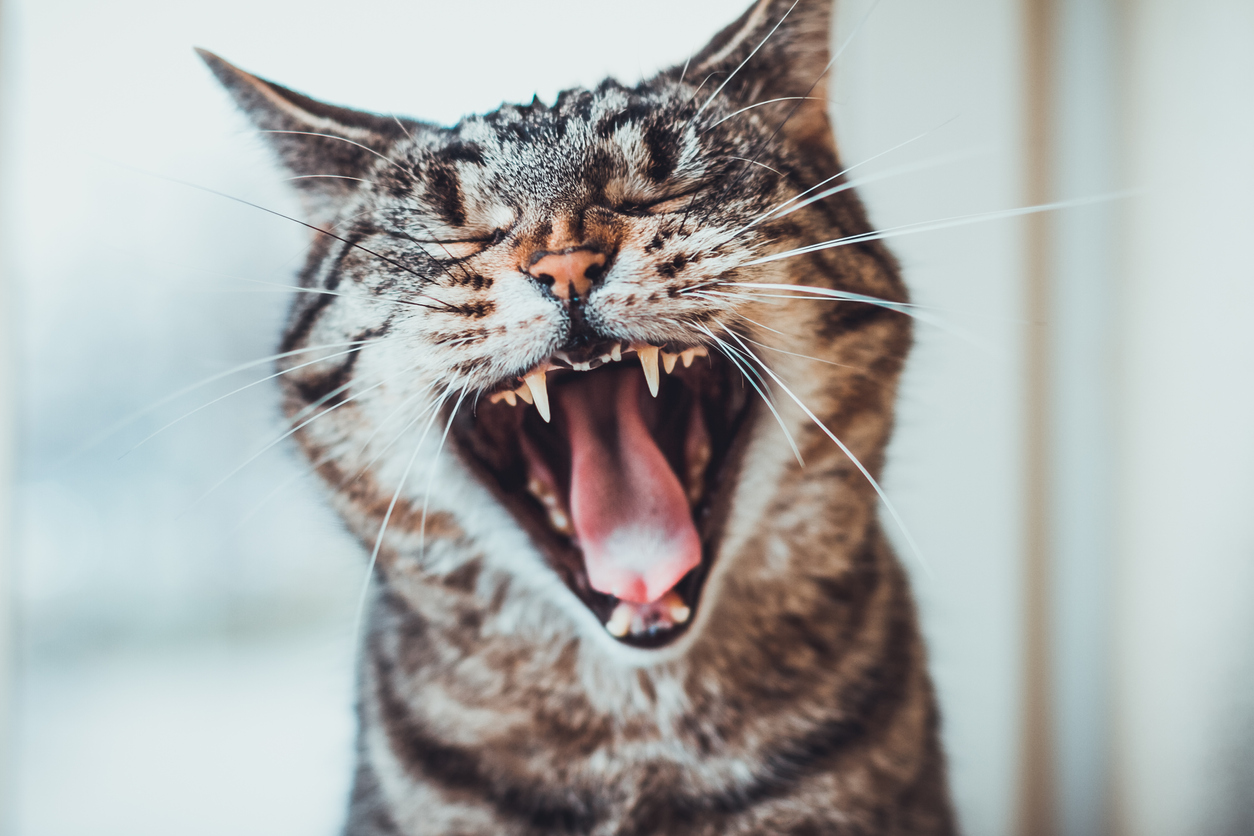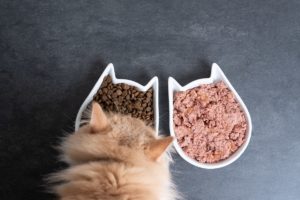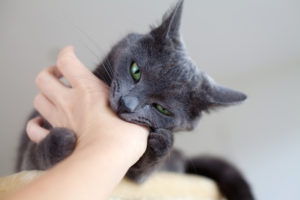If you’ve been spending quality time with your favorite feline, you’ve noticed that she uses her mouth for all kinds of important activities: grooming herself, catching toys (or even birds!), chewing on objects, and of course—eating! Your cat’s mouth is one of her most important tools in her day-to-day life, and it’s important to keep it clean and healthy—just like every other part of her body.
So, you may be wondering: Is there anything you can do at home to take care of your cat’s teeth? What types of dental disease are common in cats? Why does my cat’s breath stink? And, most importantly—what can you do as a pet parent to take care of your beloved kitty’s mouth?
Homecare
One of the best things you can do for your cat’s health is train her to have her teeth brushed! See our blog post on “How to Clean Your Cat’s Teeth” for a step-by-step instruction manual on this daunting task—we promise, it is easier to brush your cat’s teeth than you think!
If you are able to implement your brushing routine several times a week—or every day, if you can!—you can greatly reduce the amount of bacteria, plaque, and tartar in your cat’s mouth. This will help maintain your cat’s oral health, and prolong the time in between professional dental cleanings by your veterinarian (more on these below).
If you just can’t brush your kitty’s teeth, check out the pet store for dental care products that carry the Veterinary Oral Health Council (VOHC) seal of approval. These products have been certified in an independent laboratory to significantly reduce plaque and tartar build-up. You can find a list of approved products at www.vohc.org. These products include toys and treats that your cat chews to help gently scrape off the top layers of plaque from your kitty’s teeth, water additives which reduce the amount of bacteria in your cat’s mouth, and more!
Common Cat Dental Problems
Plaque and Tartar
Just like every other species on the planet, cats suffer from plaque and tartar buildup. This process occurs naturally every day, and over time can form a yellow-brown cement-like material on the surface of your cat’s teeth. This bacteria-filled tooth cement is called dental calculus, and can only be removed during a professional teeth cleaning.
Broken Teeth
Cats are also at risk for breaking teeth, just like we are! In cats, the most commonly broken teeth are the canine teeth in the front of the mouth. You might recognize these teeth as your kitty’s fangs–the long, sharp teeth that help cats catch prey in the wild.
If your cat breaks a tooth, then it’s highly likely that the tooth’s pulp cavity will be exposed. The sensitive pulp cavity is a tube running down the center of the tooth containing its blood supply and nerve. You can imagine that if a tooth breaks and the pulp cavity IS exposed, your cat will be in pain from the exposed nerve, and the exposed blood vessel will serve as a highway for bacteria to enter the jawbone. Ouch! If you notice a broken tooth at home, it’s best that your cat be evaluated by your veterinarian as soon as possible.
Periodontal Disease
While more common in dogs, cats can suffer from a condition called periodontal disease—which simply refers to inflammation of the gums and other tissues in the mouth that support the teeth. Some individuals are more prone to periodontal disease than others—and often, this condition in cats is linked to resorptive lesions (see below).
Gingivitis, or inflammation of the gums, is the earliest sign of periodontal disease. When left untreated, this can worsen and lead to loose teeth, loss of gum tissue which exposes the roots of the teeth, and bone loss affecting the jaw. As you can imagine, this condition can be quite painful for your kitty! If you notice any areas of red gums in your cat’s mouth, you guessed it—it’s time for your favorite feline to take a trip to the vet.
Tooth Resorption
One type of dental disease that is more common in cats than in ANY other species is tooth resorption. In fact, over half of cats over the age of 3 years will have at least one tooth affected by this disease process—astonishing, but true!
Tooth resorption is inflammation affecting the tooth itself and brought on by the kitty’s own immune system. It can occur in the portions of the tooth that you can see above the gumline (called the “crown” of the tooth), and/or the portions of the tooth within the jawbone and below the gumline (the roots of the tooth). Eventually, inflammation of the tooth leads to the erosion and degradation of the tooth structure…and eventually, after months or years of this process, there is no tooth remaining at all.
As you might imagine, this process is painful for the cat, especially as the nerve of the tooth is eaten away. While there is no way to prevent tooth resorption, your veterinarian can help your cat achieve a pain-free mouth by extracting the tooth if it is affected by this condition. Any cat who has had one resorptive lesion is at risk of developing this problem in other teeth, so yearly dental cleanings as recommended by your veterinarian are a must for these patients.
Unfortunately, there’s no way to prevent tooth resorption—but frequent general health exams can help your veterinarian catch this disease in the early stages, allowing your cat to experience minimal discomfort. Decades of scientific research has not found any inciting cause for the body to attack its teeth in this way—so we can promise you that, if this happens to your cat, it is simply bad luck—and NOT your fault in any way!
Stomatitis/Gingivostomatitis
The terms stomatitis and gingivostomatitis refer to a very painful condition affecting the soft tissues of the mouth. Thankfully, this is quite rare, and is easily diagnosed during a basic physical exam by your veterinarian. The hallmark of gingivostomatitis is a bright red appearance to a cat’s gums, roof of the mouth and/or back of their throat.
How does such severe inflammation happen? In some cats, the immune system can overreact to even normal levels of bacteria and plaque on the surface of the teeth. The body treats normal bacteria as a dangerous invader, and the result is that the body’s defenses are deployed on otherwise healthy tissue within your cat’s mouth. This condition is more common in cats afflicted with the Feline Immunodeficiency Virus, so if this type of inflammation is noted, your veterinarian will likely want to perform a blood test for kitty viruses.
Gingivostomatitis is EXTREMELY painful for affected cats—however, many of them are still eating to survive, and the first symptom noted at home by their owner is often “bad breath.” Cat parents may also notice their kitty dropping food from their mouth or yowling in pain while eating, losing weight, drooling, or pawing at their mouth. Fortunately, since this condition is easily diagnosed on a physical exam, pain relief can be started right away if your cat is diagnosed with this rare but painful condition.
Oral Cancer
Although cancer is a very uncommon cause of dental problems in cats, veterinarians do diagnose cats with oral cancer every year. A tumor can affect any part of your cat’s mouth: his jawbone, gums, lips, or the back of his throat. Radiographs (x-rays) and biopsies of suspicious areas may be recommended if your veterinarian is concerned about the possibility of cancer. Like many diseases, oral cancer is more common in elderly cats, as well as those affected by Feline Immunodeficiency Virus (FIV) and Feline Leukemia Virus (FeLV).
What Does Your Veterinarian Do?
Now that you know about the most common causes of dental disease in cats, how to take care of your cat’s dental health at home, and symptoms to watch for that indicate a dental problem, you may be wondering how your veterinarian can help your precious kitty!
Oral Exam
Any time your cat is taken to the veterinarian for an exam, your veterinarian will look in your cat’s mouth as part of their overall physical. Your vet can identify whether a buildup of tartar and dental calculus (that bacteria-infused “cement”) is present, as well as look for broken teeth, signs of periodontal disease, gingivostomatitis, oral tumors, and evidence of resorptive lesions above the gumline. They will also look at your cat’s lips, tongue, and the inside of their cheeks for any evidence of medical issues.
Based on the oral exam performed while your kitty is awake, your veterinarian may recommend increased homecare/tooth brushing, or a dental cleaning and radiographs (x-rays) under anesthesia.
Dental Cleaning Under Anesthesia
Your veterinarian may recommend this procedure for preventive maintenance as part of your cat’s wellness care, or because they are suspicious of a more serious medical issue after examining your cat. Since our cats can’t talk to us, it’s common for most veterinarians to recommend dental cleanings at least once a year.
Before your cat is placed under anesthesia, your veterinarian will make sure that anesthesia is as safe as possible for them by performing pre-anesthetic bloodwork. If there are any problems identified on your cat’s bloodwork, especially in the organs that are responsible for processing the anesthetic medications, your veterinarian may postpone the procedure until it is safe for your cat. In some cases, pre-anesthetic testing includes radiographs (x-rays) of your cat’s heart and lungs, and possibly other tests as well. Rest assured that any testing recommendations are tailored to your individual cat’s health status, and are made in the best interests of your cat’s health and safety!
On the day of your cat’s dental cleaning, expect your kitty to stay at the hospital all day. A sedative is given to relax your cat. This reduces your cat’s mental stress from being in the hospital and decreases the amount of general anesthetic needed (making the procedure even more safe). Your cat’s front leg may be shaved below the elbow to place an IV catheter, through which they will receive their anesthetic medications and IV fluids to support their blood pressure while they are asleep.
During anesthesia, a tube is placed down your kitty’s throat and connected to an anesthetic machine. This tube allows both oxygen and anesthetic gas to be delivered directly to your cat’s lungs, as well as protecting your sleeping cat’s airway from all of the water used in a dental cleaning. Your cat is hooked up to various monitors which continually keep track of your cat’s heart tracing, breathing, oxygen levels, blood pressure, and temperature. A warming blanket is used to help your kitty keep warm throughout the anesthetic period.
After your cat is safely under anesthesia, either a veterinary technician or your veterinarian will clean, scale, and polish your cat’s teeth—just like what happens when you have a dental cleaning! Your cat’s veterinarian will probe around each tooth, looking for gum pockets. Many veterinary practices have dental radiographic (x-ray) equipment to look for signs of disease below the gumline (such as tooth resorption). A full oral exam is also performed, looking at all surfaces of your cat’s teeth, tongue, gums, cheeks, and lips. If your cat needs advanced dental work (such as extractions or a biopsy), local anesthetics are usually given beforehand—similar to humans receiving an injection of Novocaine.
Once your cat’s dental procedure is complete, the anesthesia is turned off and your cat slowly wakes up. When they are awake enough to swallow on their own and hold their head up, the tube is removed from their throat. They will continue to recover in a cage under the observation of the veterinary team.
Your veterinarian will give you a full report of your cat’s oral health and advise if any further treatment is necessary. If your cat has stitches in his mouth, these will be absorbed over the next ten to fourteen days, and feeding soft food until his mouth is healed will be essential to his recovery. Your veterinarian may prescribe pain medication and possibly antibiotics if advanced dental work was required.
After your cat’s dental procedure, it’s time to take advantage of your cat’s “clean slate” and start a tooth-brushing regimen at home—see “How to Clean a Cat’s Teeth” for more. Ask your veterinarian when you can begin!
Promoting Dental Health Through Home and Veterinary Care
Cats are living longer than ever, in part due to advances in feline dental care. Pet parents and veterinarians working together to promote healthy teeth and gums will ensure that dental issues are identified early and kept to a minimum so as to not cause pain and discomfort for your sweet kitty!
If you have any questions about your cat’s oral health, our AskVet Veterinarians are available to discuss all of your pet’s needs 24 hours a day, 7 days a week. Whether you have an immediate need or are looking to improve your pet’s overall wellbeing, just sign into your account and one of our friendly and knowledgeable veterinary experts will attend to your needs, no appointment required!
Written by:
Allison Ward, DVM
Dr. Allison Ward grew up in the suburbs of Washington, D.C. and started working in veterinary hospitals when she was 14 years old. After graduating from veterinary school in 2011, she completed a small animal rotating internship in New Jersey, followed by a neurology/neurosurgery internship in Miami. After completing this advanced training, Dr. Ward then moved on to general small animal practice. Dr. Ward’s professional interests include feline medicine, neurology, and pain management. Her passion for educating pet owners carries over into her work with AskVet, and she loves being able to help pets and their parents at all times of the day (and night!). She currently resides in sunny south Florida with her two cats, Larry and George.








